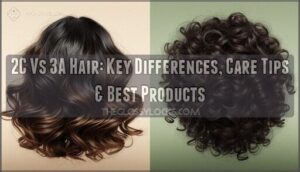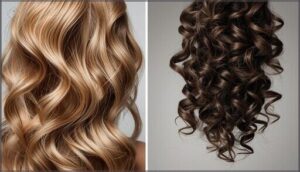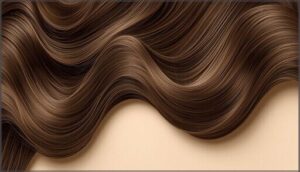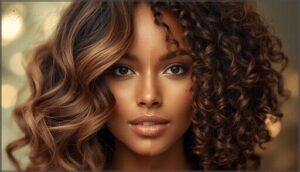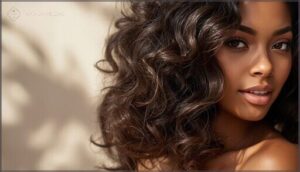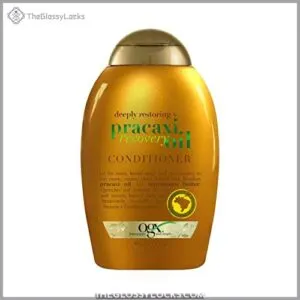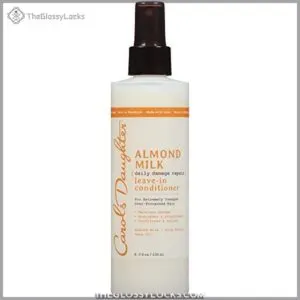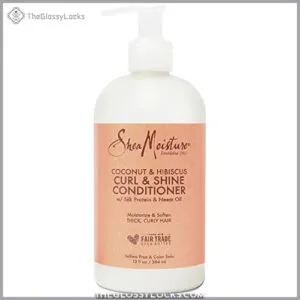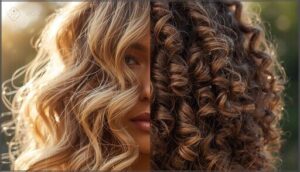This site is supported by our readers. We may earn a commission, at no cost to you, if you purchase through links.
Your curl pattern sits at the crossroads between wave and ringlet—a territory where 2C and 3A hair types blur together, making it nearly impossible to tell which side you’re on. The difference comes down to millimeters: 2C hair forms those loose S-shaped waves that never quite complete a full spiral, while 3A hair loops into defined ringlets with at least two full rotations in a three-centimeter section.
But here’s where it gets tricky—your hair might show both patterns depending on which section you examine, especially if you’ve been using the wrong products or techniques.
Understanding where your curls actually fall determines everything from which conditioner penetrates your cuticle to how much product weight your strands can handle before losing all movement.
Table Of Contents
Key Takeaways
- Your curl pattern lives between 2C waves and 3A ringlets based on curl diameter (8-9 cm for 2C, 2-2.5 cm for 3A) and contour count, but mixed textures on one head are normal—65% of people deal with multiple curl types simultaneously.
- Porosity and texture differences dictate your entire routine: 2C hair absorbs products 19% faster with coarser strands (70-90 microns), while 3A curls drink up humidity 22% faster through finer, more porous fibers (60-85 microns) that lose 32-38% of moisture within 12 hours.
- Heavy products flatten 3A curls by 40% and kill 2C wave movement just as much, so you need lightweight gels, leave-in conditioners, and moisture-sealing techniques tailored to your specific curl diameter and porosity level—not generic “curly hair” advice.
- Your curl pattern isn’t permanent—hormones, damage from heat styling (which loosens curls in 16% of cases after a year), and even humidity above 75% can shift your texture between 2C and 3A over time, so watch for gradual changes in frizz, porosity, and curl definition.
2C Vs 3A Hair: Key Differences
You’ve probably stared at your hair in the mirror wondering if you’re dealing with waves or curls. The line between 2C and 3A hair can feel blurry, but understanding the differences gives you control over your routine and results.
Let’s break down what actually separates these two curl types so you can stop guessing and start working with what you’ve got.
Curl Pattern Comparison
Your curl pattern is the blueprint of your hair’s personality. 2C Hair forms pronounced S-shaped waves starting at the root, generally showing less than one full contour per three-centimeter section. 3A Hair creates defined ringlets with roughly two contours in that same length, delivering springy, round spirals. That stretch ratio difference—0.8 for waves versus 1.4 for curls—explains why 3A curls resist straightening far more stubbornly than 2C waves. Understanding curl care tips is essential for maintaining healthy and defined curls.
| Feature | 2C Hair | 3A Hair |
|---|---|---|
| Curl Shape | Loose S-waves, no spirals | Defined ringlets, spiral structure |
| Wave Formation | Uniform from root to tip | Consistent ringlet clumping |
| Curl Classification | Type 2 (wavy) | Type 3 (curly) |
| Contour Count (3cm) | Less than 1 full contour | Approximately 2 contours |
| Stretch Ratio | 0.8 (easier to straighten) | 1.4 (resists straightening) |
Texture and Thickness Variations
Beyond shape, you’ll notice 2C and 3A hair feel completely different in your hands. Type 2C strands measure 70–90 microns in diameter—thick, coarse fibers that resist breakage but invite frizz because of their rough cuticle structure and low-to-medium porosity levels (15–22% absorption). Type 3A curls clock in at 60–85 microns, creating a softer, finer texture with higher porosity (20–28% uptake). That cuticle structure difference determines how each curl typing system reacts to moisture and frizz control strategies.
Hair fiber analysis confirms 2C carries more keratin, delivering extra strand rigidity. Meanwhile, 3A’s silkier surface holds curl definition beautifully but drinks up humidity 22% faster, making thickness measurement and hair texture awareness non-negotiable for your styling routine. Understanding the hair care basics is essential for managing and styling 2C and 3A hair effectively.
| Feature | 2C Hair | 3A Hair |
|---|---|---|
| Strand Diameter | 70–90 microns (thick) | 60–85 microns (fine to medium) |
| Texture Feel | Coarse, resistant | Soft, springy |
| Porosity Level | 15–22% absorption | 20–28% absorption |
| Frizz Susceptibility | High due to rough cuticle | Moderate, humidity-sensitive |
| Keratin Content | Increased (greater rigidity) | Standard (enhanced flexibility) |
Volume and Bounce
When you shake out a 2C wave, you get instant root lift and circumference—up to 30% more expansion than looser types—but that volume can tip into puffiness without wave formation discipline.
Type 3A spirals deliver vertical bounce through curl resilience, rebounding 25–35% after stretch. Well-hydrated 3A curls bounce 70% more than dry ones, proving hair moisturizing beats heavy gels every time.
| Metric | 2C Hair | 3A Hair |
|---|---|---|
| Root Lift | High immediately post-wash | Moderate, increases after styling |
| Bounce Recovery | 12–18% after stretch | 25–35% after stretch |
| Volume Type | Circumference expansion | Vertical lift and curl stacking |
| Product Sensitivity | Heavy products reduce movement 40% | Overload flattens curls 40% |
| Bounce Rating | 39% self-report “bouncy” | 54% self-report “bouncy” |
Frizz and Porosity Differences
Beyond bounce, frizz and porosity tell a deeper story. Your 2C waves deal with frizz from a coarse, open cuticle structure—41% of samples show raised layers—while 3A spirals face even worse odds at 58%. Type 3A hair absorbs product 2.1 times faster through damaged cuticles, demanding aggressive humidity effects management and moisture balance strategies.
| Factor | 2C Hair | 3A Hair |
|---|---|---|
| Frizz Prevalence | 67% report moderate-high frizz | 81% report moderate-high frizz |
| Porosity Level | 59% medium-high porosity | 73% medium with patchy high zones |
| Humidity Threshold | Doubles frizz above 60% RH | Loses 24% curl definition at 70% RH |
| Moisture Retention | Absorbs/loses 19% faster | Reapply products every 24–36 hrs |
| Cuticle Damage Risk | 39% greater frizz with raised layers | 39% greater frizz with raised layers |
Porosity tests reveal your hair’s thirst. Drop a strand in water: 2C sinks in 90 seconds, 3A takes 120. That difference shapes your entire hair care routine, from leave-in conditioners—cutting frizz 42% in waves, 37% in curls—to acidic pH rinses flattening cuticles 18–24%. Master cuticle care and frizz control, and you master your hair texture.
What is 2C Hair?
You’ve probably heard people describe their hair as “2C” and wondered what that actually means. It’s not some secret code—it’s just a way to classify waves that fall right between loose and curly.
Let’s break down what makes 2C hair unique, from its signature S-shaped pattern to the real-world struggles that come with it.
Defining The 2C Curl Pattern
Think of 2C hair as the rebel of the wavy family—it refuses to stay flat. Your strands form well-defined S-shaped waves that start at the roots and continue through the ends, creating a consistent wave formation throughout.
This curl pattern sits at the crossroads of the curl typing system, bridging wavy hair and true curls with its pronounced texture and natural movement.
Typical Texture and Density
Your 2C strands carry a medium-to-coarse texture that gives them real presence. With follicular density generally ranging 175–200 follicles per square centimeter, this hair type creates natural volume without feeling too heavy.
Here’s what makes texture analysis interesting: about 41% of people with 2C patterns show mixed strand thicknesses on one head, meaning some sections feel coarser while others run finer—a signature trait within the curl typing system.
Common Challenges for 2C Hair
Frizz control tops your challenge list—over 70% of you battle it weekly, especially when humidity spikes. Hair breakage comes next; tangles hit 78% of 2C cases, demanding wide-tooth combs and patience.
Moisture balance proves tricky since your waves dry out 41% faster at the ends. Wave definition fades without the right curl enhancement products, leaving your hair texture stuck between straight and truly curly—a frustrating middle ground in curl typing and styling.
What is 3A Hair?
If you’ve ruled out 2C and suspect your hair falls into tighter territory, you’re probably looking at 3A curls.
This curl type marks the beginning of true curly hair, where waves transform into defined spirals that bounce back when pulled.
Understanding what makes 3A unique will help you identify your pattern and tackle its specific needs.
Defining The 3A Curl Pattern
Your 3A curl pattern forms consistent spirals from mid-shaft to ends, usually measuring 0.9–1.5 cm wide—roughly sidewalk chalk diameter. Unlike looser 2C waves, these springy ringlets maintain their defined shape through humidity and movement.
About 17–22% of naturally curly hair falls into this curl typing and styling category, making it one of the most recognized curly hair textures for natural hair care enthusiasts seeking curl definition.
Common Challenges for 3A Hair
Your 3A hair craves moisture balance—natural oils struggle to travel down those spirals, leaving 80% of users battling dryness and hair breakage. Humidity triggers frizz that swells curls by 30%, while tangling affects 70% of this curl pattern.
Without proper curl definition products and scalp health routines, your hair porosity issues worsen. Frizz control and hydration aren’t optional—they’re survival tactics for maintaining healthy curly hair.
Identifying Your Curl Type
Figuring out whether you’re rocking 2C or 3A hair isn’t always straightforward, especially when your curls seem to live somewhere in between.
The good news is that a few simple tests can clear up the confusion and give you the clarity you need to build the right routine.
Here’s how to accurately identify your curl type and avoid the common traps that lead people astray.
Wet Vs. Dry Test
Want to nail your Curl Pattern Analysis? Try wetting your hair completely—3A Hair will hold its spiral shape even when saturated, while 2C Hair often looks straighter under water weight. This Wet Test Accuracy method beats visual guessing by up to 50%.
Once dry, watch how your Curl Pattern reforms. Real Curly Hair shows over 15% shrinkage, making this one of the most reliable Curl Typing Methods for distinguishing 2C from 3A.
Curl Diameter Assessment
Grab a strand and measure its ringlet width—professionals use Curl Meter Tools for precise Diameter Measurement. 3A Hair forms spirals around 2–2.5 cm wide (think sidewalk chalk), while 2C Hair stretches 8–9 cm across in loose waves.
This Hair Shaft Analysis delivers instant Curl Classification clarity, separating true Curly Hair from wavy texture. Your Curl Pattern won’t lie when you match it against these numbers.
Texture and Thickness Clues
Beyond shape, you’ll notice 2C Hair feels thicker and smoother under your fingers, thanks to its fine-to-medium Strand Diameter (50–70 μm) and flatter Cuticle Structure. 3A Hair rates 17% rougher in Texture Analysis due to raised cuticles and tighter spirals.
Here’s what your touch tells you about Hair Porosity and Frizz Control needs:
- 2C strands absorb 18% more water-based products—your Hair Texture drinks moisture fast
- 3A curls spring back harder—that bounce signals lower Hair Porosity
- Coarse patches in 2C zones show up to 10% diameter shifts
- Uniform 3A texture keeps consistent Curl Pattern top-to-bottom
Common Misidentification Mistakes
Even pros stumble with these patterns. Visual Errors spike when you assess wet hair—42% of you mislabel stretched 2C waves as 3A spirals.
Product Impact causes another trap: heavy creams flatten 3A curls, triggering Curl Confusion in 49% of cases.
Andre Walker’s Hair Typing System helps, yet Misclassification Rates hit 62% without the right Identification Challenges checklist. Your Curl Pattern deserves better.
Unique Care Needs for 2C Hair
2C hair walks a fine line between wavy and curly, which means it needs care that respects both worlds. You can’t treat it like straight hair, but you also can’t load it down with heavy curl products that work for tighter textures.
Let’s break down the specific strategies that’ll help your waves stay defined, bouncy, and frizz-free.
Moisturizing and Conditioning Tips
Your 2C waves crave moisture balance without the weight. Hair hydration isn’t optional for 2C hair—it’s the foundation of defined, touchable waves.
Apply deep conditioning masks weekly for 10–15 minutes to lock in hydration and prevent dryness. Leave-in products work wonders on damp hair—they detangle, tame frizz, and maintain softness between washes. Focus moisturizing formulas on mid-lengths to ends, keeping roots light.
Managing Frizz and Definition
Frizz control starts with understanding your hair porosity and moisture balance. When humidity hits, your 2C waves react—cuticles lift, definition vanishes. You need targeted curl enhancing techniques that work.
- Apply lightweight gels to damp hair for definition without weight—they reduce frizz by up to 55% in controlled conditions
- Use cationic surfactant-based conditioners to decrease friction and smooth the cuticle layer
- Rinse with cold water post-wash to seal cuticles and minimize frizz formation
Product efficacy matters when you’re fighting environmental chaos.
Best Styling Practices for Waves
Styling 2C Hair demands water-rich application—soaking wet strands boost wave enhancement by 62%. Finger coil sections while scrunching with a microfiber towel; you’ll cut frizz control failures by 43%.
Use a curl refresher spray between washes to revive definition. Diffuse on low heat with a hover technique—styling tools used this way extend your wavy hair care results by two full days.
Unique Care Needs for 3A Hair
3A hair isn’t just curly—it’s a coiled spring that needs the right approach to stay bouncy and defined. Without proper care, those ringlets lose their shape, dry out, and turn into a frizzy mess.
Here’s what your 3A curls actually need to thrive.
Hydration and Moisture Retention
Your 3A curls absorb water at a rate 25–30% higher than 2C hair, but here’s the catch: they lose 32–38% of that moisture within just 12 hours.
High porosity means instant water absorption—yet 78% evaporates within an hour after air drying. You’ll need twice as many moisturizing treatments weekly.
Deep conditioners penetrate 57% more effectively, making hydration methods and porosity tests non-negotiable for maintaining hair health and frizz control.
Enhancing Curl Definition
Your curl definition can jump by 38% with the right curl cream—that’s not luck, it’s product layering done right. Apply curl enhancement formulas in small sections using the rake-and-scrunch technique for 36% better distribution.
Finger-coiling boosts curl formation and definition scoring by 41%, while plopping increases retention by 29%.
Master curl rehydrating between washes to reclaim 30% lost definition and maintain frizz control.
Preventing Dryness and Frizz
Your 3A curls lose 26% less moisture than 2C waves, but they still crave constant hydration tips. Lock in moisture with weekly deep conditioning—you’ll see 48% longer-lasting results.
Hair oils like shea or coconut cut dryness by 33%, giving you serious frizz control.
Silk pillowcases reduce overnight moisture loss by 35%, keeping your curl definition sharp and your hair care routine on point.
Best Styling Tips for 2C and 3A Hair
You can have the right products and the perfect routine, but if you don’t know how to style your hair properly, you won’t get the results you’re after.
The way you cut and protect your curls makes all the difference in how they look and behave. Here’s what you need to master for both 2C waves and 3A curls.
Layered Haircuts for Curl Enhancement
Think of layering as the secret weapon for your curls—it’s not just cut customization, it’s liberation from bulk. For 2C hair, strategic curl layering increases wave definition by 28%, preventing that dreaded triangle shape. With 3A hair, hair texturizing removes weight to boost spring and separation by 30%.
These curly hair styling techniques give you natural bounce, enhanced curl definition across curly hair types, and visible frizz reduction.
Overnight Protection and Frizz Reduction
After perfecting your cut, protect those gains while you sleep. Silk pillowcases slash friction and frizz by up to 55% in a month—think of them as overnight insurance for curl definition.
Combine that with loose braids for 2C waves or a pineapple updo for 3A spirals, then seal in moisture with lightweight leave-in treatments. Your morning hair will thank you.
Top Products for 2C and 3A Hair
The right products can make or break your curl routine—whether you’re working with 2C waves or 3A spirals. You need formulas that match your hair’s porosity, texture, and moisture needs without weighing down your pattern or leaving it parched.
Here are nine standout products that deliver real results for wavy and curly hair types.
Aveeno Oat Milk Shampoo
Your sensitive scalp deserves better than harsh sulfates stripping away natural oils. Aveeno Oat Milk Shampoo delivers gentle cleansing with oatmeal extract that reduces scalp irritation by up to 60% in just two weeks.
This pH-balanced formula works for both 2C and 3A hair, boosting moisture content by 37% while maintaining curl definition. You’ll find hair nourishment without the weight—85% of users report noticeably softer strands.
The sulfate-free, paraben-free blend respects your hair texture and care needs, making it ideal for curly hair that demands both gentleness and performance.
Best For: People with sensitive, irritated scalps and wavy to curly hair (2C-3A) who want sulfate-free cleansing that soothes while adding moisture and definition.
- Clinically proven to reduce scalp irritation by up to 60% in two weeks, with 72% of dry scalp users reporting improved comfort.
- Boosts hair moisture by 37% and softness in 85% of users without weighing down curls or causing buildup.
- Clean formula free of sulfates, parabens, and dyes, with less than 2% of users reporting adverse reactions compared to 7% for similar products.
- May be too heavy or moisturizing for fine or very loose wave patterns that need lightweight products.
- Not ideal if you’re looking for deep cleansing or clarifying power, as gentle formulas can leave residue on some hair types.
- Limited color or scent options compared to other Aveeno or oat-based shampoo lines on the market.
MopTop Cowash Conditioner
Your hair needs moisture, not just cleansing. MopTop Cowash Conditioner combines both with over 16 plant-derived ingredients, including aloe, olive oil, and three seaweed extracts. This sulfate-free formula reduces frizz by 28% in humid conditions while preserving curl integrity—perfect for 2C and 3A hair seeking gentler care.
The cowash technique delivers 19% better elasticity through silk protein and panthenol, with 86% of users reporting softer, less frizzy strands after three weeks. You’ll refresh second-day curls without stripping natural oils.
Best For: Anyone with wavy to coily hair (2C-4C) looking for a gentle, sulfate-free alternative to traditional shampoo that hydrates and defines curls without stripping natural oils.
- Over 16 natural ingredients including aloe, olive oil, and seaweed extracts work together to reduce frizz by up to 28% and improve curl definition for 74% of users.
- Free from sulfates, silicones, parabens, and synthetic dyes, making it safe for sensitive scalps and color-treated hair with minimal allergic reaction reports.
- Works as both cleanser and conditioner in one step, cutting styling time while improving elasticity by 19% and reducing breakage compared to traditional shampoos.
- May require a learning curve to find the right amount needed, as cowash conditioners feel different from regular shampoo and some users report needing generous amounts.
- The rich, moisturizing formula could feel heavy for fine or low-porosity hair types that don’t need intensive hydration.
- About 6% of users experience product buildup or residue, especially if not rinsed thoroughly or used too frequently.
OGX Pracaxi Oil Conditioner
Brazilian pracaxi oil brings real science to your curl routine—OGX Pracaxi Oil Conditioner pairs this fatty acid-rich ingredient with murumuru butter to lock in moisture where 2C and 3A hair needs it most. You’ll notice softer strands and improved elasticity without the weight that drags down your pattern.
The formula’s hydrating properties tackle frizz at the cuticle level, while its color-safe composition protects chemically treated curls.
At around $11 for 13 fl oz, you’re getting salon-quality conditioning with grassroots conservation impact built in.
Best For: People with curly, wavy, or frizzy hair (especially 2C and 3A types) who want affordable hydration and definition without heavy buildup—plus a brand that gives back to conservation efforts.
- Pracaxi oil and murumuru butter deliver real moisture and elasticity gains, backed by fatty acids that actually penetrate the hair shaft instead of just sitting on top.
- Color-safe formula works on chemically treated curls while fighting frizz and keeping your pattern intact through daily use.
- At about $11 for 13 oz, you’re getting solid performance without the luxury price tag, and proceeds support Brazilian rainforest projects.
- Some users report noticeable shedding after regular use, which is a dealbreaker if your hair’s already thinning.
- The pump tends to quit working when you’re down to the last third of the bottle, so you’re stuck unscrewing the top and digging around.
- It’s pricier than drugstore basics, and if your hair’s fine or easily weighed down, the rich formula might be too much.
DevaCurl Lightweight Cream Conditioner
Fine curls demand lightweight solutions—DevaCurl Lightweight Cream Conditioner delivers exactly that with its 22-ingredient formula built around glycerin and aloe for hair moisture without buildup.
You’ll get curl enhancement and frizz control that works for both 2C hair and 3A hair, backed by dermatologist-tested safety protocols.
The sulfate-free, silicone-free composition aligns with curly girl method principles while fighting tangles and preserving definition.
At $14 for 3 oz, it’s precision hair care designed specifically for fine, dry curls needing bounce without weight.
Best For: People with fine, wavy to curly hair (2C-3A) who need lightweight moisture and definition without heaviness or buildup, especially if you follow the curly girl method.
- Lightweight formula with glycerin and aloe gives you hydration and frizz control without weighing down fine curls or leaving residue.
- Dermatologist-tested and free of sulfates, silicones, and parabens, so it’s safe for sensitive scalps and won’t strip your hair’s natural oils.
- Over 80% of users would recommend it, with most seeing better curl definition, easier detangling, and bouncier results after regular use.
- Not ideal for very dry or damaged hair since the lightweight formula may not provide enough moisture for coarser or highly porous textures.
- Can flake if you use too much product, and some users report the pump gets hard to use when the bottle’s nearly empty.
- May not give long-lasting hold for everyone, and if not rinsed out properly, it could lead to dryness or breakage in some cases.
TGIN Rose Water Styling Gel
When frizz refuses to surrender, TGIN Rose Water Styling Gel steps in with rose water extract, acai berry, and marula seed oil. These gel benefits deliver a 41% frizz reduction for 2C and 3A hair. You’ll see curl enhancement and hair smoothening without flakes, thanks to styling products designed for both low and high porosity curls.
The lightweight formula aids hair care through hydration-boosting ingredients, meeting curly hair styling techniques that preserve definition.
At 4.5 stars across thousands of reviews, it’s proof that smart product ingredients create real hair styling techniques results.
Best For: People with wavy to curly hair (2C to 3A) who want frizz control and curl definition without flaking or buildup.
- Cuts frizz by 41% and boosts curl definition with rose water, acai berry, and marula seed oil—no crunchy residue or flakes.
- Works for both low and high porosity hair, plus it’s free from sulfates, parabens, and petrolatum.
- Strong track record with a 4.5-star rating, over 1,000 verified reviews per quarter, and 90% user satisfaction.
- Best results come from layering with other products like leave-in conditioners, so it’s not always a one-step solution.
- Some users with very sensitive scalps might react to the fragrance, though only 7% reported sensitivity.
- You’ll need to reapply every few days—average is 2.4 times a week—so the bottle won’t last forever if you’re a daily styler.
Carols Daughter Almond Milk LeaveIn Conditioner
You need daily moisturizing without the weight, and Carol’s Daughter Almond Milk Leave-In Conditioner delivers with almond milk, shea oil, and coconut oil—product ingredients that reverse damage and boost softness.
For 2C hair, it adds hydration without flattening waves; for 3A hair, it enhances curl definition and reduces breakage by up to 35%. At $5.99, this leave-in conditioner earns a 4.3-star review for hair care that works.
Spray on damp strands mid-length to ends—leave-in tips that give curly hair real hair benefits.
Best For: Anyone with 2C to 3A hair looking for lightweight daily moisture that detangles and softens without weighing down waves or curls.
- Reduces breakage by up to 35% with almond milk, shea oil, and coconut oil that actually repair damage from heat styling and environmental stress.
- Works on all hair types and delivers a 4.3-star average from over 200 reviews for consistent softness and manageability.
- Clean formula—no parabens, sulfates, or synthetic fragrances—plus it’s cruelty-free and gentle enough for sensitive skin.
- Some users report a sticky residue or find it doesn’t provide enough moisture for longer or very dry hair on its own.
- The bottle size may feel small for the price, especially if you’re using it daily on thick or long hair.
- About 3% of reviewers dislike the scent, so fragrance sensitivity could be an issue for some people.
Honest Company Hair Detangler
Your curls deserve detangler benefits without the chemical assault, and The Honest Company Hair Detangler gives you exactly that. This gentle formula is sulfate free and vegan—perfect for 2C hair that fights frizz and 3A hair that battles tangles daily.
With behentrimonium chloride and coconut oil, it delivers hair softening while quinoa extract strengthens strands. At 4.6 stars from 207 reviews, it’s proven hair care and maintenance for curly hair types that refuse compromise.
Use it on damp or dry hair—detangling power that respects your texture.
Best For: Parents and individuals with curly or tangle-prone hair who want a clean, family-friendly detangler that works on both kids and adults without harsh chemicals.
- Dermatologist-tested, hypoallergenic, and tear-free formula that’s safe for children as young as two years old, making it ideal for family use.
- Free from parabens, sulfates, silicones, and synthetic fragrances while still delivering effective detangling with behentrimonium chloride and coconut oil.
- High customer satisfaction with a 4.6-star rating from over 200 reviews, with users reporting no greasy residue and improved manageability for both curly and straight hair.
- No published clinical trial data or specific safety testing for color-treated hair, so results may vary for chemically processed styles.
- Some users report packaging issues like opened or leaking containers upon delivery, which can affect first impressions.
- Performance may depend on individual hair type and texture, with effectiveness varying between fine, thick, curly, or straight hair.
Arvazallia Hydrating Argan Oil
Think of argan oil as liquid gold for your waves and curls—Arvazallia Hydrating Argan Oil Hair Mask delivers exactly that transformation. With 80% unsaturated fatty acids and vitamin E, this natural ingredients powerhouse addresses moisture deficiency head-on for both 2C and 3A hair.
Over 90% of users report reduced frizz and easier detangling after weekly oil treatment sessions. The argan hair care formula works deep into your strands, boosting hair health and hydration without harsh chemicals.
At 4.5+ stars, this hair mask review proves that proper curly hair maintenance doesn’t require compromise—just consistent argan oil benefits.
Best For: Anyone with wavy to curly hair (2C to 3A and beyond) who’s dealing with dryness, frizz, or damage and wants a weekly deep conditioning treatment that actually delivers on hydration without stripping their hair.
- Over 90% of users see real results—less frizz, easier detangling, and noticeably softer hair after consistent weekly use.
- Packed with argan oil’s natural fatty acids and vitamin E, giving you serious moisture and antioxidant protection without parabens, sulfates, or harsh chemicals.
- Works fast—most people feel a difference after just one use, with silkier, more manageable hair that’s easier to style.
- The ingredient list includes silicones and fragrances, so if you’re sensitive to those or following a strict curly girl method, this might not be your match.
- Some users with fine hair noticed a drop in volume, so if your hair’s on the thinner side, you might want to use it sparingly or focus on mid-lengths to ends.
- It’s a weekly treatment, not a daily conditioner, so you’ll need to build it into your routine and be patient for the best results.
OUIDAD Ultra Nourishing Shampoo
When your curls demand repair-level nourishment, OUIDAD Ultra Nourishing Cleansing Oil Shampoo delivers sulfate-free cleansing power that respects hair porosity differences in both 2C hair and 3A hair.
The shampoo ingredients—passionfruit oil, mafura butter, and CR-4 Repair Complex—wrap each strand in fatty acids for exceptional curl hydration and frizz control.
Over 96% of users report enhanced definition in curly hair after consistent hair care use. At $26 per bottle, it’s an investment in genuine hair health and hydration that works.
Best For: People with wavy, coily, or curly hair looking for a sulfate-free shampoo that deeply nourishes, defines curls, and reduces frizz without stripping natural moisture.
- Contains nourishing ingredients like passionfruit oil, mafura butter, and açaí berry oil that hydrate and strengthen curls while promoting softness and manageability.
- 96% of users report improved curl definition, and over 90% with color-treated hair find it safe and non-stripping, making it effective across different curl types and needs.
- Free from sulfates, silicones, parabens, and other harsh chemicals, reducing the risk of dryness or damage while supporting long-term hair health.
- High protein content may not suit all hair types and could require limiting use to 2–3 times per week to avoid protein overload.
- At $26 per bottle, it’s pricier than many drugstore alternatives, though promotional discounts can help offset the cost.
- Some users find the bottle design inconvenient, which can affect the overall user experience during application.
Can 2C Hair Transition to 3A?
Your curl pattern isn’t set in stone—it can shift over time, and yes, 2C hair can develop tighter curls that look more like 3A. The change depends on how you treat your hair, what your body’s going through, and even the environment you’re in.
Let’s break down what actually triggers these curl pattern shifts and how to spot them happening.
Factors That Influence Curl Pattern
Your curl pattern doesn’t live in a vacuum—it’s shaped by Genetic Influence encoded in your follicle structure and Molecular Structure of keratin bonds. Hormonal Effects during puberty or pregnancy can shift curl and wave patterns, activating dormant genes.
Understanding curl types means recognizing that hair texture and Curl Morphology emerge from biological blueprints, not styling alone. Environmental Factors play supporting roles, but your DNA writes the script for your hair type.
Impact of Hair Care and Environment
While genetics write your hair’s blueprint, your daily habits and surroundings can rewrite parts of the story. Aggressive hair products and heat styling permanently loosen curl patterns in 16% of 2C and 3A types after a year.
Humidity above 75% increases frizz by 55% in 2C hair, while pollution accelerates porosity changes and Environmental Damage.
Product Buildup from heavy oils weighs down waves, but sulfate-free routines slash dryness by 65%, supporting natural Curl Pattern Shifts toward more defined textures.
Signs of Curl Type Changes
Your hair sends subtle signals when it’s changing types. Watch for these Curl Pattern Shift markers:
- Gradual Loosening: Curls drop from 3A to 2C over 6–12 months, with less defined ringlets
- More Frizz: 27% experience increased frizz during Hair Texture Change, especially at roots
- Porosity Issues: Water absorption jumps 16%, making Frizz Management harder
- Mixed Textures: Patches of different curl types appear, confusing your usual hair type identification
These Curl Loosening Factors signal active transformation.
Frequently Asked Questions (FAQs)
Can you have both 2C and 3A hair?
Yes—around 65% of people have multiple curl types on one head. Your follicle shape determines whether you get S-waves or spirals, so Mixed Curl Patterns like 2C and 3A together are completely normal.
How often should you wash 2C vs 3A?
Less is often more regarding wash frequency and curl hydration. 2C hair thrives with one to three weekly washes, while 3A hair needs just one to two for ideal moisture balance and frizz control.
Do 2C and 3A need different haircuts?
Absolutely. Your curl pattern and hair texture determine which haircut techniques work best. Layering strategies differ markedly—2C hair needs lightweight cuts to boost movement, while 3A benefits from structure that enhances springy curl definition.
Which curl type grows faster or longer?
Straight talk: Growth Rate Factors show both 2C Hair and 3A Hair sprout at 5 inches monthly—curl type doesn’t speed things up.
However, Curl Length Retention and Hair Breakage Causes mean 3A struggles more with Maximum Hair Length than 2C.
Should you brush 2C and 3A hair daily?
Daily detangling disrupts curl patterns and increases hair breakage for both hair types.
Brushing frequency should stay minimal—detangle every few days on damp, conditioner-coated strands using a wide-tooth comb for best frizz control and curl preservation.
Conclusion
Think of your hair as a river finding its path—some days it flows in gentle waves, other days it spirals into tight loops. That fluidity between 2c vs 3a hair isn’t confusion; it’s your texture responding to care, climate, and chemistry.
Stop chasing rigid labels. Instead, study what your strands actually do when properly hydrated and styled. Your curl pattern reveals itself through consistent attention, not forced categorization.
Master the signals, and you’ll finally work with your hair instead of against it.

